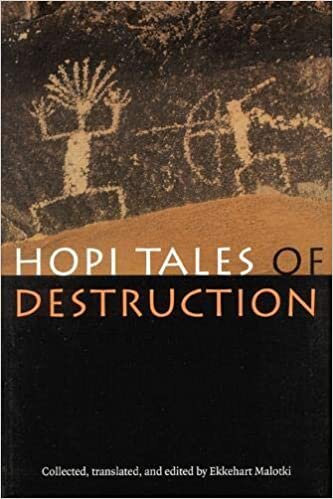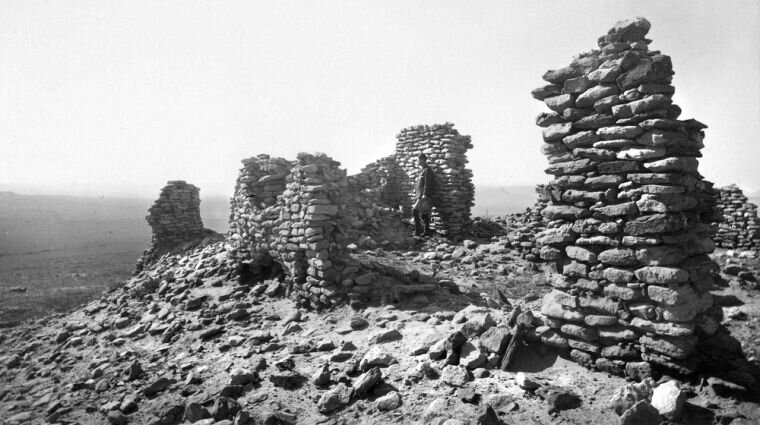Hopi Tales of Destruction collected by Ekkehart Malotki Book Review
HopI Tales of Destruction [Amazon link] is a collection of legends narrated by Michael Lomatuway’ma, Lorena Lomatuway’ma, and Sidney Namingha Jr, and translated by Ekkehart Malotki. As you might guess from the title, each story features some dramatic act of devastation. Malotki has also provided helpful commentary before each story, placing the story in the context of oral traditions in general, and Hopi oral traditions in specific, as well as linking to available archeological or historical information.

Like two other books I have read recently, Wooden Leg [Amazon link] and Geronimo's Story of His Life [Amazon link], Hopi Tales of Destruction is an opportunity to hear someone’s story in their own words, albeit with a necessary filter of translation.
Unlike the other two books, this volume is not autobiographical, but a documentation of the kind of stories that were told for entertainment and edification by the Hopi. Seven tales are collected here, enough to give some idea of the different kinds of stories that were told about villages or people that came to ruin, and also to see the similarities and themes that unite these particular kinds of stories.
The overarching theme of all these stories is that moral dissolution eventually leads to destruction. Koyaaniqatsi is the Hopi word that describes this state: a life of turmoil and disorder. How this comes about varies a bit in the stories. The village of Hisatsongopaavi comes to ruin because of an attempt to convince the water serpents that lived in the nearby spring to flatten the cliffs into usable farmland. Pivanhonkyapi, on the other hand, is destroyed by a firestorm from the southwest called down by a leader who is saddened that his people have fallen into a life of pleasure-seeking.

Sunset Crater
By NPS Photo - https://www.flickr.com/photos/naturenps/29991535786/in/album-72157669131446614/, Public Domain, https://commons.wikimedia.org/w/index.php?curid=79568105
Two of the stories collected here refer to a firestorm coming from the southwest, perhaps an echo of the eruption of Sunset Crater in the 11th century AD. Malotki and Michael Lomatuway’ma have another volume specifically about that event, Earth Fire [Amazon link], but the descriptions in the stories here are strikingly similar, of fire shooting up into the sky near Nuvatukya’ovi [San Francisco Peaks].
Another interesting element is Palangwu, the home of the sorcerers far to the northeast. Sorcerers are said to extend their life by stealing the heart of a relative and placing it into a jar at Palangwu. A similar story was used by Jerry Pournelle and Larry Niven in Burning Tower, locating the ur-heimat of the Uto-Aztecans in the San Juan river valley to the northeast the Hopi Pueblos, and featuring an immortal Emperor who extends his life by taking hearts and placing them in jars.

Awat’ovi
Palace of the Governors Photo Archive Negative Number 29947
The final story in this volume, and the reason I asked for a copy of this book, is the annihilation of Awat’ovi. This story, as noted by Malotki, is quite different in structure than the other six, possibly because the events are so recent. The story is in two parts, the first is told in a manner very much like the rest, with a standard structure and references to legendary figures. The second part gets oddly specific, shifting from complaints about sorcerers to ones about the Spanish, and featuring details of a conspiracy amongst the other Hopi villages to destroy Awat’ovi and massacre all of its inhabitants.
The ruins of Awat’ovi are about an hour and a half east of where I live, but I hadn’t heard of this story until recently. Awat’ovi was the first village the Spanish encountered when they first came to the area, and it also was where the primary center of mission work to the Hopi was established, Mission San Bernardo de Aguatubi. During the Pueblo Revolt, the mission was destroyed, but once the Spanish re-established control, missionaries returned to Awat’ovi and found a receptive audience, according to both Spanish and Hopi versions of the event.
In an entirely successful move to eliminate further inroads by the missionaries, the town was burned and its residents killed, with a few survivors taken to the other villages. At the time of its destruction, Awat’ovi was the largest Hopi village, with something like 800 residents. The total Hopi population at the time was estimated at something like 2200 people, so the Hopi killed about 1 in 3 of their own in order to preserve themselves from outside influence.
This harsh measure arguably worked, and as the other stories in this volume attest, this kind of a solution is something that was imaginable when the people fell away from traditional practices. However, much like similar acts committed by Catholics, such as the Albigensian Crusade, the feeling now seems to be “let’s not do that again'“. Within the last hundred years, the split between Hopi who wanted a more traditional way of life and those who were open to Western ways was resolved by the founding of new villages, Hotevilla and Kykotsmovi, where people with different ways of life could live apart from one another.
I highly recommend this volume, it is a fascinating piece of local history, and a valuable insight into Hopi culture.



Comments ()